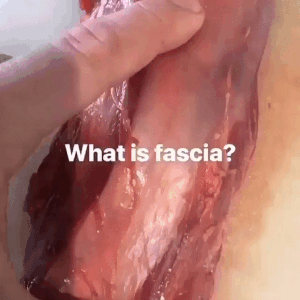WHAT IS FASCIA
FASCIA
You know, each organ in the body is separated and supported to be able to independently function, "slide" on top of each other, but still be able to effectively link and transmit signals to each other.
Yes, there is a very important system that takes on this responsibility, and that is FASCIA. A system can easily be forgotten when most medical information tells us about our organs and systems separately.
You can easily visualize FASCIA through this image

Fascia is composed of connective tissue with the main components being protein and water. With the main role of linking, shaping, enveloping, and communicating.
Recently, Fascia has been included in medical curricula thanks to its excellent functionality. Fascia spread throughout our body and forms membranes that cover the entire muscles and tendons, give strength to the ligaments, form fluidity in blood and body fluids, envelop organs, blood vessels, and nerves, and fill body cavities, has a protective and supporting role. The fascia links the skin to organs and structures located deeper below; It even forms the internal structures of the cell itself. In the course of performing all of these roles, the Fascia has formed a three-dimensional network throughout our body.
You can also visualize more vividly and visually how your skin resembles an orange peel. If your skin is the outer layer of an orange peel, then the thicker, white, fibrous layer right next to the skin will be your fascia. Just like when peeling an orange, people often discard the white fibers thinking that these bonding fibers have no effect. However, in the last 20 years studies have found that fascia is not only a useless white substance, but in fact, the fascia surface contains a lot of sensory receptors for movement, position, pressure, pain, and even more than the surface of the skin.
In its normal state, Fascia in liquid form contains a large percentage of water, which corresponds to 70% of the water content of our body. Its high fluid content makes it possible for the fascia to move freely as we move, constantly switching shapes, and its complex three-dimensional network can adapt itself to each need we need.
In addition to the shallow fascia layer located just below the skin, the body also includes the deeper fascia layer on a larger scale. Let's take a look at a series of internal organs that our bodies all (mostly) encapsulate in the abdominal and pelvic cavities: the liver, stomach, kidneys, spleen, bladder, and uterus or prostate, not to mention the 9m long pipe known as the digestive canal. Each of these parts needs to maintain its area of space and at the same time be able to adapt to our body movements. Even a simple act like bending down to tie your shoelaces requires all of these organs to move and slide easily, to maintain a harmonious spatial environment. It is the fascia layers that can move freely like an oil-smooth plastic wrap, wrapped around the above-mentioned organs, that make it possible for these organs to move like that.
How does Fascia work?
Understanding how Fascia works is key to harnessing the power of Fascia in treating chronic pain.
The Fascia has a pulling force of 2,000 lb (~907kg) per square inch (roughly equivalent to the force of a panda's body weight sitting on you!). It is the power of Fascia that helps hold the body into an interconnected mass, maintain its shape, and help the body move.
On the inside of the body, the Fascia creates a perfectly balanced, strong, and flexible structure, and can adjust accordingly to changes in tension acting on it without losing its structural state. In architecture, such structures are called Tensegrity. Tensegrity structures create remarkable flexibility and ruggedness but the texture is very gentle. You will not be surprised to know that this structure is used by NASA to design extraterrestrial robots thanks to its outstanding advantages.
The Tensegrity structure of Fascia helps shape its strength and structure. The high water content of Fascia gives it another property related to resilience and bounce.
The mesh protein membrane binds water to the fascia, giving it the ability to resemble a trampoline that is elastic and bounces. This ability is called elastic viscosity. The combination of water and protein in Fascia creates a gel-like consistency with properties known as thixotropy.
The thixotropy property is the ability to change the consistency significantly, switching from gel to liquid, and from gel to more solid. Thixotropy properties are activated by heat and mechanical forces. If you expose a substance with thixotropy properties to a fast, strong force, it will immediately produce a resistance reaction and become more solid, but if you apply a continuous gentle massage, it will "melt" and become liquid. Trixotropy properties help explain why injuries to high-force wounds, such as accidents or surgery, can cause the fascia to become thickened and blocked (causing problems); and it also explains how to release obstructed Fascia through gentle warm massage in highly practical myofascial release (MFR) therapy.
Between these two extremes, thixotropy and certain other properties of proteins also explain how excessive use of organs over a continuous time can lead to fascia becoming gelatinous and thick, leading to repetitive exercise injuries and chronic conditions.
Again, it helps explain how MFR can successfully treat these conditions.








